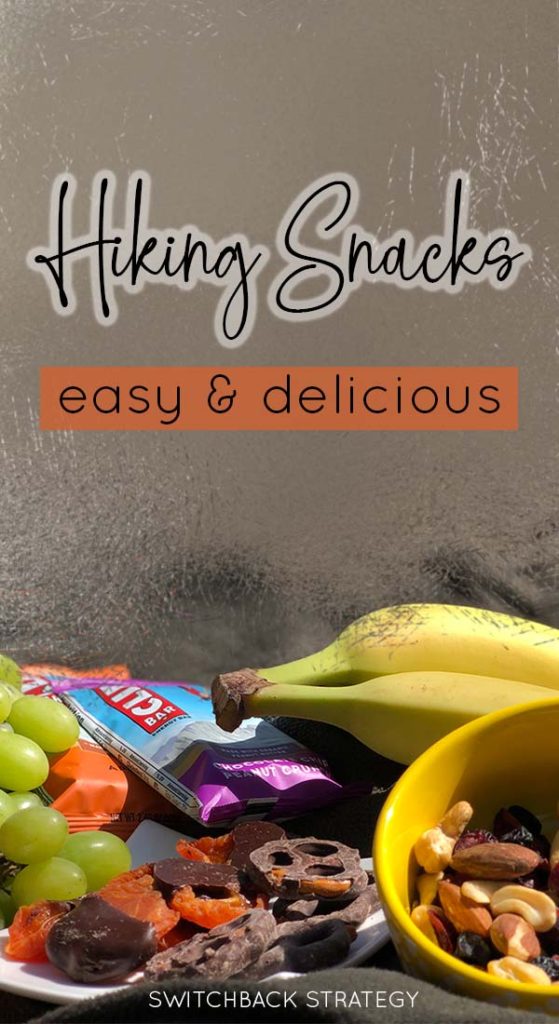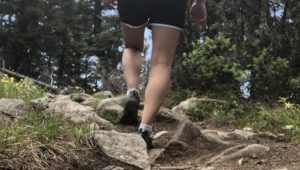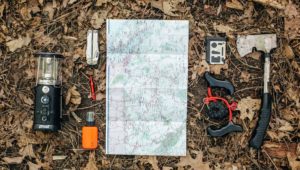Anyone that thinks having good snacks is not an essential survival skill, has never seen me hungry. If I had a dollar for every time I have had to say “I’m sorry for what I said when I was hangry,” well.. I probably wouldn’t be starting this blog.
I have an obsession with food, so it is only fitting that my hiking posts start with snacks.
While I will admit, it may not be the most important part of hiking, I feel no guilt that it is what I probably put the most thought into. I mean, who doesn’t love good snacks?!
Hiking snacks are different in that they need to be efficient and effective as well as tasty. Poor planning can either leave you hungry and crashing (like bringing a bag of candy), or can weigh you down and leave you sorer at the end (packing a full picnic lunch for example). So how do you plan properly? Keep reading and you’ll learn how to balance out the snacks you need.

Disclosure: This post may contain affiliate links, which means I may receive a small commission, at no cost to you, if you make a purchase through a link on this blog. I would never recommend a product I don’t use or love myself.
Planning out what you need
Calories
The best foods will be:
- Calorie rich to provide fuel and keep you full
- Lightweight
- Easy to pack and carry
Good foods will be high in carbohydrates, proteins, and healthy fats. Empty calorie foods will leave you hungry and make you crash.
Calories are energy.
You need the right amount of energy to obtain peak athletic performance. According to Mayo Clinic, on average, a 160 lb person will burn about 438 calories/hour hiking. So you’ll need about 1750 calories for 4 hours of hiking. Adjustments can be made for weight and length of the hike.
For some examples of how food converts to calories:
- 1 apple ~ 95 calories
- 1 banana ~ 105 calories
- ¼ cup trail mix ~173 calories
Nutrient Types
Carbs are quick and easy energy. They break down fast to give your muscles a quick boost.
Fat is the other main energy source your body uses, and unless you are trail running, your body will use a lot of fat for energy. What you want is healthy fats, like those found in nuts, seeds, fish, coconut.
Protein can be used for energy, but it is not as preferred. The importance of protein is for muscle repair and balancing blood sugar levels.
Don’t forget to start your day with a solid meal, a healthy and filling breakfast before hitting the trail will keep you full for hours and require you to carry less in your pack.
What do you pack?
A hiking snack pack should have a combination of nutrients. My ultimate pack will have a mix of sweet and salty. It will also have a combination of juicy and dry, the juicy is perfect when you’re thirsty, but the dry is easier to stash in a pocket and snack on consistently to keep energy levels high. Your hiking staples will include:
1. Fruit
Examples: Apple, Grapes, Peach, Banana, Avocado, Dried Mango, Dried Apricot, Raisins, Dates, Dried Coconut
Fresh Fruit is my absolute favorite thing to bring when hiking, juicy and sweet, nothing tastes better. The extra water quenches thirst making is an exceptionally tasty treat. It is also the heaviest and bulkiest thing to carry, so the longer the hike is, the less likely I am to bring fresh fruit and will opt for Dried Fruit instead. It is a great source of carbs, which is quick energy.
Get creative: Dried mango, dried pineapple, chocolate covered apricots (these are amazing!), dates
2. Nuts and Seeds
Examples: Trailmix, Cashews, Almonds, Macadamia, Pecans, Peanuts, Peanut Butter, Almond Butter, Cashew Butter, Pumpkin Seeds, Sunflower Seeds
Confirm that no one you are traveling with has a serious nut ALLERGY before you head out for the trail, the last thing you want is to have an anaphylactic emergency without access to medical assistance.
Nuts pack well and are easy to carry. They are a calorie-dense protein and high in fat. They are filling and make a great choice for packing.
Get creative: Candied nuts, wasabi almonds
Trail mix can be premade or homemade. Making trail mix can be easily done by combing a couple of different nuts with some dried fruit and/or chocolate (just remember that chocolate melts in the heat).
Get creative: mix in chocolate-covered ginger or chocolate covered pretzels
Nut Butter is another great source of fat and protein. You can eat it straight as is, whip up a peanut butter sandwich, apples with almond butter
Get creative: peanut butter pretzels, ants on a log (celery with nut butter)
Seeds are another great source of protein and healthy fats. They can easily be mixed with nuts and dried fluid for a packable trail mix.
3. Energy Bar
Examples: Cliff Bar, Lara Bar, Kind Bar, Paleo Bar, Homemade Bar, Energy Bites
Bringing an Energy Bar is the densest and most lightweight way to get a lot of the calories and energy you need quickly. I always have as least one in my pack. I will admit, they are not always my favorite thing to eat, but on long hikes I appreciate the low weight to high calories a bar can offer. They pack a lot of the nuts, fruits, carbs that I would pack individually into a condensed packet.
4. Jerky
Examples: Beef Jerky, Turkey Jerky, Bison Jerky
Jerky is packed full of protein. While protein is not as quickly accessible as high carbs, it can help to refuel muscles and is good for balancing blood sugar levels
My Grab and Go Pack
Everyone’s calorie requirements will vary depending on the variables described earlier, but this is my regular quick grab
- Trips under 4 hours – trail mix, energy bar, water
- All day trips – trail mix, energy bar, peanut butter/banana/honey sandwich, single serving of fruit, water
Tips for new hikers
Are you reading this and new to a sport? BRING GOOD SNACKS!
If you are just starting, you may soon start looking to up your game. This could be longer day trips, weekend backpacking, winter hiking, rock climbing, whatever gets your heart racing. In these situations, you may need to turn to others to provide some of the technical expertise needed to venture out. But no matter what, you can always contribute something.
My recommendations if you are new and venturing out with a group are to do the following:
- Do your homework. Look at a map. Know where you are going.
- Come prepared. Find out what you need to bring and don’t show up empty-handed.
- Be willing. Pitch in and help out when you can.
- Stand out. SNACKS. This is where snacks can be useful. Fresh baked cookies, a thermos of hot chocolate, some juicy fresh fruit. Doing something small that is just slightly above and beyond can be a great way to contribute the skills you have.
- Be Positive.
Special treats are not something that I routinely pack, and I don’t recommend it on a regular basis, but sometimes it’s good to treat yourself. Sometimes it’s good to treat others. The other time it is particularly handy is if you’re out with kids, having something special can make it a more enjoyable experience for everyone.
Treats
Examples: Cookies, hot chocolate, chocolate covered pretzels, gummy bears, cheese, brownies, fresh fruits
My first time ice climbing, I had very little to contribute, I was borrowing 90% of the gear and relied on a friend to lead and set up all the routes. As a thank you, I filled my pack with fresh baked cookies, cheese and grapes, hot chocolate, and an extra sandwich. It may seem small, but it gets appreciated, and it made me feel like I had something to offer in the overall experience.
Going Gourmet
80% of the time I stick with my grab and go pack, it’s easy and I always have the supplies around. But like I said earlier, I LOVE food. So on occasion, it’s nice to change things up.
Any of these is going to be heavier to carry though, so I would only recommend it for shorter or easier trails where you can spend some extra time.
- Spam musubi (spam rice ball) – this is maybe one of my favorite things
- Bean and cheese burrito
- Tex Mex crunch wrap
- Hummus and veggie wrap
- Slice of pizza
- Vietnamese summer rolls
- Half an avocado filled with tuna salad
Be aware that if anything you bring has dairy or meat and it is going to be hot out, you need to be sure that it won’t spoil.
Water
Snacks are fun, but having enough Water is the MOST IMPORTANT thing to plan out. Water makes up about 60% of your body weight and your body needs it for survival. Water requirements depend on a lot of factors: trip length, temperature, humidity, the intensity of the trail, age, gender, physical fitness, location.
Water Requirements
Water requirements are relative to how much fluid you lose from sweating; therefore, the more you sweat, the more water you need. Expect to need more water if:
- More elevation change is expected
- The hike will be long
- It will be hot and/or humid
- You are male
- You weigh more
There are some general guidelines for how much water to drink. You want to be sure to drink water before, during, and after your hike.
- Before: 3 cups of water 2 hours prior
- During: 3-6 cups/hour (about 1 L/hour)
- After: 3 cups for each pound lost due to sweating
If the hike will pass by a natural water source, like a river, lake, or stream, then bringing a portable water filter (Sawyer, Lifestraw, Katadyn) is a great way to ensure you will have adequate water, while decreasing pack weight.
Deyhdration
If you start to notice any of the following then you need to drink more water, these are signs of dehydration:
- Thirst
- Chills
- Clammy skin
- Elevated heart rate
- Nausea
- Headache
- Dizziness
- Shortness of breath
- Dry mouth
Dehydration needs to be avoided because it can lead to heat exhaustion, heatstroke, muscle cramping/fatigue, and breakdown of muscle.
Snacks are fun for everyone, it is easily the most exciting planning part of adventures. Get creative, have fun with it. And enjoy the trails.
xoxo, Wayfarer
What is the next hike that you are planning, and what are you most excited about?



